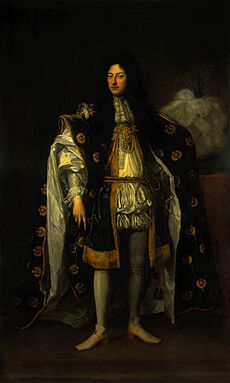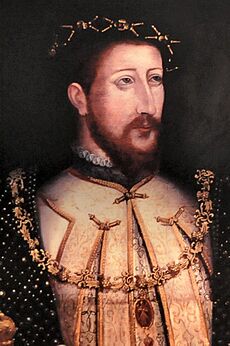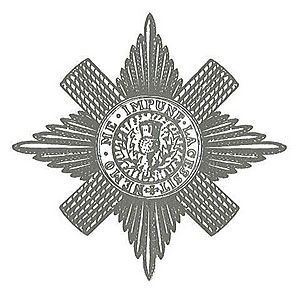Order of the Thistle facts for kids
Quick facts for kids Most Ancient and Most Noble Order of the Thistle |
|
|---|---|
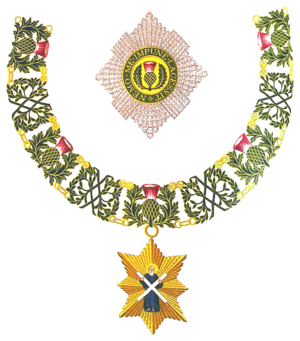
Insignia of Knights and Ladies of the Most Ancient and Most Noble Order of the Thistle
|
|
| Awarded by the monarch of Scotland (United Kingdom) and successor states | |
| Type | Order of chivalry |
| Established | 1687 |
| Motto | Nemo me impune lacessit |
| Criteria | At the monarch's pleasure |
| Status | Currently constituted |
| Founder | James VII |
| Sovereign | Charles III |
| Chancellor | The Duke of Buccleuch and Queensberry |
| Classes |
|
| Statistics | |
| First induction | 29 May 1687 |
| Total inductees |
|
| Precedence | |
| Next (higher) | Order of the Garter |
| Next (lower) | Order of St Patrick |
Ribbon of the Order of the Thistle |
|
The Most Ancient and Most Noble Order of the Thistle is a special group of knights and ladies connected to Scotland. It's like a very old club that honors people for their great achievements. The current version of this order was started in 1687 by King James VII. He said he was bringing back an even older order.
The Order of the Thistle has the King or Queen (called the "Sovereign") and sixteen knights and ladies. There are also "extra" knights and ladies, who are usually members of the British royal family or kings and queens from other countries. The Sovereign is the only one who decides who gets to join the order. They don't need advice from the government, which is different from most other orders.
The main symbol of the order is the thistle, which is the national flower of Scotland. The order's motto is Nemo me impune lacessit. This is Latin for "No one provokes me with impunity." You can also see this motto on the Royal coat of arms of the United Kingdom used in Scotland. The special saint of the order is St Andrew.
The United Kingdom has many orders of chivalry, but the three most important ones are each linked to a different country. The Order of the Thistle is for Scotland and is the second most important. The most important is the Most Noble Order of the Garter, which is for England and started in the 1300s. There was also an order for Ireland, the Most Illustrious Order of St Patrick, but it is no longer active.
Contents
History of the Order
King James VII said he was bringing back an old order, but there isn't much proof of this. One story says the order started in 786 after a battle where the cross of St Andrew appeared in the sky. Another story says it began in 809 to celebrate a friendship between a Scottish king and Emperor Charlemagne. Some even say Robert the Bruce started it after his big victory at Bannockburn in 1314.
Most historians think the order might have truly started with James III in the 1400s. He used the thistle as a royal symbol and put it on coins. There might have been a Scottish order of knights in the 1500s, possibly started by James V, but it didn't last.
In 1687, King James VII officially "revived and restored" the Order of the Thistle. He wanted to reward Scottish people who were loyal to him. Only eight members were chosen at first.
After James VII was removed from power in 1688, no new members were added for a while. However, Queen Anne started appointing knights to the order again in 1704. Since then, the order has continued to exist. It is used to recognize Scots who have done important work in public service or helped their country in a big way.
First Knights of the Order (1687)
When King James VII brought back the order in 1687, he chose eight people to be the first knights. Here are some of them:
- James Drummond, 4th Earl of Perth: He went into exile with King James in 1688.
- George Gordon, 1st Duke of Gordon: He was exiled but later returned and was pardoned.
- John Murray, 1st Marquess of Atholl: He made peace with the new government in 1689.
- James, Earl of Arran: He was confirmed in his titles by the new King William III.
- John Drummond, 1st Earl of Melfort: He also went into exile with King James.
Who Can Join the Order?
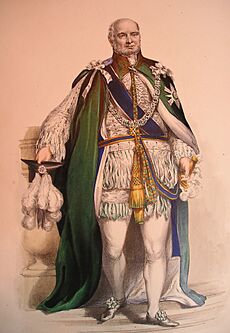
The King or Queen of Scotland (and later the UK) has always been the leader, or "Sovereign," of the Order. When James VII restarted the order, he said there would be twelve knights, like Jesus and his Twelve Apostles. In 1827, King George IV increased the number to sixteen members.
For a long time, only men could be knights. But in 1937, King George VI made his wife, Queen Elizabeth, a Lady of the Thistle. Then, in 1987, Queen Elizabeth II allowed women to regularly join both the Order of the Thistle and the Order of the Garter.
Sometimes, special people can join the order as "Extra Knights" or "Extra Ladies." These members don't count towards the sixteen-member limit. Members of the British royal family often join this way. The first person from outside the royal family to be an "Extra Knight" was King Olav V of Norway in 1962.
The Sovereign used to choose knights based on advice from the government. But King George VI felt that the orders were being used for political reasons, not just to reward deserving people. So, in 1946, he decided that the Sovereign would personally choose members for the Order of the Thistle and the Order of the Garter.
Knights and Ladies of the Thistle can also join the Order of the Garter, which is even more senior. In the past, many knights would leave the Order of the Thistle if they joined the Garter, but this doesn't happen anymore.
A Knight or Lady can also lose their knighthood. This has only happened once, to John Erskine, 6th Earl of Mar, who lost his knighthood after being part of a rebellion in 1715.
The order has five main officers: the Chancellor, the Secretary, the Dean, the Lord Lyon King of Arms, and the Gentleman Usher of the Green Rod. The Dean is usually a religious leader from the Church of Scotland. The Chancellor looks after the order's seal. The Gentleman Usher of the Green Rod carries a green staff. The Lord Lyon King of Arms is in charge of Scottish heraldry (family symbols and coats of arms).
The Thistle Symbol
The thistle is a very important symbol for Scotland and the Order. According to a legend, a long time ago, an invading army from Norway tried to sneak up on a Scottish army at night. One barefoot Norwegian soldier stepped on a thistle and cried out in pain. This noise woke up the Scottish soldiers, who then defeated the invaders. Some people think this happened at the Battle of Largs in 1263.
What Members Wear
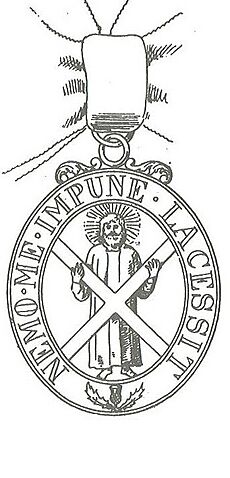
For special events, like the annual service or coronations, the Knights and Ladies wear fancy clothes:
- The mantle is a long green robe worn over their regular clothes or uniforms. It has a white lining and green and gold tassels. On the left shoulder, it has the star of the order.
- The hat is made of black velvet and has white feathers with a black egret or heron feather in the middle.
- The collar is made of gold and has thistles and sprigs of rue (a plant). It's worn over the mantle.
- The St Andrew (also called the badge-appendant) hangs from the collar. It's a gold picture of St Andrew holding a white cross.
For less formal events, members wear simpler items:
- The star is a silver cross with rays. In the middle, there's a green circle with the order's motto in gold letters. Inside the circle, there's a thistle on a gold background. It's pinned to the left side of the chest.
- The broad riband is a dark green sash worn across the body, from the left shoulder to the right hip.
- The badge is attached to the right hip of the riband. It shows St Andrew surrounded by the order's motto.
When a Knight or Lady passes away, their special items like the badge and star must be returned to the Sovereign.
The officers of the order also wear green robes. The Gentleman Usher of the Green Rod carries a green rod.
The Thistle Chapel
When King James VII started the modern order, he wanted the Abbey Church at the Palace of Holyroodhouse to be its chapel. But he was removed from power, and the chapel was destroyed. The order didn't have its own chapel until 1911. That's when a new one was added to St Giles High Kirk in Edinburgh.
Every year, the Sovereign stays at the Palace of Holyroodhouse for a week in June or July. During this visit, a service for the order is held every two years. Any new knights or ladies are officially welcomed into the order at these annual services.
Each member of the order, including the Sovereign, has a special seat, or "stall," in the chapel. Above their stall, their family symbols (called heraldic devices) are shown. For knights, this includes their helmet and crest. For ladies, it's usually just their coronet (a small crown).
When a Knight passes away, their helmet, crest, and sword are taken down. But their stall plates, which show their name, symbols, and when they joined, stay on the stall forever. This means the chapel is filled with a colorful history of all the knights and ladies since 1911. The names of members from before 1911 are written on the walls outside the chapel.
Importance and Privileges
Knights and Ladies of the Thistle have a high rank in Scotland. They rank above almost all other knights and baronets. The wives, sons, and daughters of Knights of the Thistle also have a special rank.
Knights of the Thistle use "Sir" before their first name, and Ladies use "Lady." For example, Sir John or Lady Mary. They also use special letters after their name: "KT" for Knights and "LT" for Ladies. These letters usually come before most other honors.
Members can also show their arms (family symbols) with a green circle that has the order's motto and collar around them. The badge hangs from the collar. In Scotland, the Royal Arms (the King's official symbol) show the collar and motto of the Order of the Thistle.
Knights and Ladies can also have special "supporters" for their arms. These are figures, like animals or people, that stand on either side of their shield. This is a very special privilege, shared only by royal family members, peers, and other high-ranking knights.
Current Members and Officers
Sovereign
| Name | Year of appointment | Present age |
|---|---|---|
| King Charles III (ex officio) | 1977 as The Duke of Rothesay; Sovereign since 2022 | 76 |
Extra Knights and Ladies
| Name | Year of appointment | Present age | Arms |
|---|---|---|---|
| Anne, Princess Royal KG, KT, GCVO, GCStJ, QSO, GCL, CMM, CD, ADC | 2000 | 75 | |
| Prince William, Duke of Rothesay KG, KT, GCB, PC, ADC(P) | 2012 as The Earl of Strathearn; Duke of Rothesay since 2022 | 43 | |
| Queen Camilla LG, LT, ONZ, GCVO, GBE, CSM, CD, PC | 2023 | 78 | |
| Prince Edward, Duke of Edinburgh KG, KT, GCVO, CD, ADC | 2024 | 61 |
Knights and Ladies
| Member number | Name | Known for | Year of appointment | Present age | Arms |
|---|---|---|---|---|---|
| 1-(200) | Andrew Bruce, 11th Earl of Elgin KT, CD, JP, DL | Lord Lieutenant of Fife | 1981 | 101 |  |
| 2-(213) | James Mackay, Baron Mackay of Clashfern KT, PC, KC, FRSE | Lord Chancellor | 1997 | 98 |  |
| 3-(214) | David Wilson, Baron Wilson of Tillyorn KT, GCMG, FRSE | Governor of Hong Kong | 2000 | 90 |  |
| 4-(217) | David Steel, Lord Steel of Aikwood KT, KBE, PC | Presiding Officer of the Scottish Parliament | 2004 | 87 |  |
| 5-(218) | George Robertson, Baron Robertson of Port Ellen KT, GCMG, PC, FRSA, FRSE | Secretary General of NATO | 79 |  |
|
| 6-(219) | William Cullen, Baron Cullen of Whitekirk KT, PC, KC, FRSE, FREng | Lord President of the Court of Session and Lord Justice General | 2007 | 89 |  |
| 7-(221) | David Hope, Baron Hope of Craighead KT, PC, KC, FRSE | Deputy President of the Supreme Court of the United Kingdom | 2009 | 87 |  |
| 8-(222) | Narendra Patel, Baron Patel KT, FMedSci, FRSE | Chancellor of the University of Dundee | 87 | ||
| 9-(224) | Robert Smith, Baron Smith of Kelvin KT, CH, FRSGS | Governor of the British Broadcasting Corporation | 2014 | 81 | |
| 10-(225) | Richard Scott, 10th Duke of Buccleuch KT, KBE, CVO, DL, FSA, FRSE, FRSGS | Lord Lieutenant of Roxburgh, Ettrick and Lauderdale | 2017 | 71 | |
| 11-(226) | Sir Ian Wood KT, GBE | Businessman and philanthropist | 2018 | 83 | |
| 12-(227) | Lady Elish Angiolini LT, DBE, KC, FRSA, FRSE | Lord Advocate, Principal of St Hugh's College, Oxford | 2022 | 65 | |
| 13-(228) | Sir George Reid KT, FRSE | Presiding Officer of the Scottish Parliament | 86 | ||
| 14-(229) | Sue Black, Baroness Black of Strome LT, DBE, FRS, FRSE, FRAI, FRSB | President of the Royal Anthropological Institute of Great Britain and Ireland | 2024 | 64 | |
| 15-(230) | Helena Kennedy, Baroness Kennedy of The Shaws LT, KC, FRSA, | Chair of the British Council | 75 | ||
| 16- | Vacant | ||||
Officers
- Dean: David Fergusson OBE, FRSE, FBA (2019)
- Chancellor: Richard Scott, 10th Duke of Buccleuch KT, KBE, CVO, DL, FSA, FRSE, FRSGS (2024)
- King of Arms: Canon Joseph Morrow CVO, CBE, KC, DL, FRSE, Lord Lyon King of Arms (ex officio, 2014)
- Secretary: Elizabeth Roads LVO, OStJ (2014)
- Usher: Rear Admiral Christopher Layman CB, DSO, LVO, Gentleman Usher of the Green Rod (ex officio, 1997)
Images for kids
-
Swords, helms and crests of Knights of the Thistle above their stalls in the Thistle Chapel. Lady Marion Fraser's helm and crest are second from the left.
See also
 In Spanish: Orden del Cardo para niños
In Spanish: Orden del Cardo para niños



